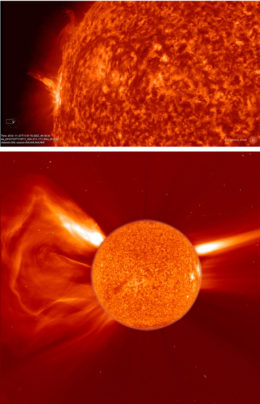
Could coronal mass ejections (bottom panel) be driven by the same mechanism as the much smaller coronal jets (top panel)? [NASA]
Different Sizes, Same Jets?
Coronal jets are frequent, short-lived eruptions of plasma that are launched from low in the Sun’s atmosphere and travel outward through the corona. These ejections occur frequently across the Sun’s surface, lasting for ~10 minutes at a time and reaching lengths of ~50,000 km — a few times the Earth’s diameter, but still tiny compared to their enormous cousins, CMEs.
Despite the difference in size scales, a team of scientists led by Peter Wyper of Durham University has proposed that both coronal jets and CMEs are launched by the same mechanism, a process known as “magnetic breakout”. In a recent publication, Wyper and collaborators show the results of a series of 3D magnetohydrodynamic simulations of coronal jets to see what we would expect to observe from magnetic-breakout-driven eruptions.
Breaking Free
In the magnetic breakout model, magnetic field lines above filaments break and reconnect, removing confinement and allowing the filament to erupt from the Sun’s surface. Wyper and collaborators simulate this process by modeling a small bipolar structure on the Sun’s surface, embedded in a background magnetic field. They then observe how the magnetic fields rearrange themselves over time.

Schematic of the evolutionary sequence that produces breakout jets. The growing, twisted flux rope is shown by the yellow field lines. [Wyper et al. 2017]
- Filament channel formation
Free energy is stored in a mini-filament or flux rope embedded within a background larger-scale magnetic field. - Breakout
Slow reconnection of the magnetic field lines above the growing flux rope eventually leads to a critical point where the flux rope can rapidly reconnect with the external field, breaking out. - Eruptive jet
As the filament escapes, it rapidly unwinds its twist and accelerates surrounding plasma along with it, causing the sudden eruption of an energetic, helical jet. - Relaxation
After several minutes, the jet propagates away, the reconnection subsides, and the fields relax into a new equilibrium similar to the starting point.
A Match to Observations
Wyper and collaborators run three sets of simulations with differing inclinations of the background magnetic fields, and they show that magnetic breakout in all three cases can lead to the production of broad, twisting jets with features consistent with what we’ve observed on the Sun.
In particular, the differing background field inclinations lead to a diversity of reconnection outflows preceding the jets. For highly inclined fields, for instance, a fast, dense outflow is driven with an inverted Y shape; for vertical fields, the outflows form much weaker spires.
All of these behaviors have been observed, and Wyper and collaborators’ model ties them together into a unified picture of coronal jet launching that has also been proposed to describe CMEs on a larger scale. If this picture is correct, then it may be possible that the complexities of these different solar eruptions can all be boiled down to one underlying process.

Eruption sequence for an inclined background field at a) 16 minutes, b) 24 minutes, and c) 31 minutes. [Wyper et al. 2018]
Citation
P. F. Wyper et al 2018 ApJ 852 98. doi:10.3847/1538-4357/aa9ffc


4 Comments
Pingback: Driving jets from the Sun
Pingback: February 21, 2018 | Colorado Space News
Pingback: The Sun vs. Your Uncle: Chromosphere Edition | astrobites
Pingback: The Sun vs. Your Uncle: Chromosphere Edition